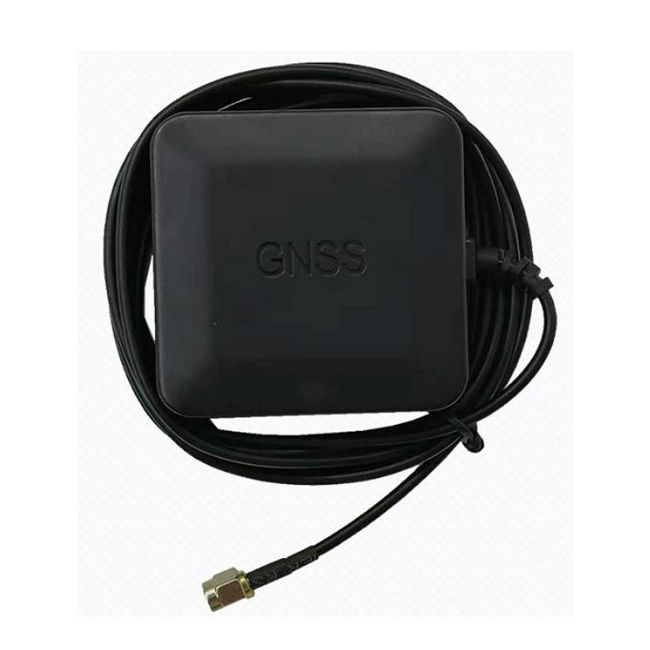An antenna is a device that radiates RF signals from a transmission line into the air or receives them from the air into the transmission line. It can also be considered as an impedance converter or energy converter. It converts the guided waves transmitted over the transmission line into ** electromagnetic waves propagated in the media, or the reverse transformation.
For wireless transceiver devices applied to RF systems, the design and selection of antennas is an important component. A good antenna system optimizes the communication range. The size of the same type of antenna is proportional to the wavelength of the RF signal. The lower the signal frequency, the larger the antenna required
Classification of antennas
The installation position can be categorized into external antenna and internal antenna, installed inside the device is called internal antenna, installed outside the device is called external antenna.
For small products such as handheld devices, wearable designs, smart homes, etc., the built-in antenna is generally used for high integration and beautiful product appearance. IoT and smart hardware products need to transmit data online, so they need to use antennas.
The smaller the space, the more frequency bands, the more complex the antenna design, the external antenna is generally a standard product, you can use the antenna of the required frequency band, no need to debug, plug and play.
For example, courier cabinets, vending machines, etc., generally use magnetic external antennas, which can be sucked on the iron case. These antennas can not be placed in the iron cabinet, the metal will shield the antenna signal, so it can only be placed outside, this article from the classification of the antenna and the selection method as the core of the antenna information.
1.1 External antenna
Radiation field radiation angle of different external antennas can be divided into omnidirectional antennas and directional antennas.
Omnidirectional antenna spatial radiation diagram
Omnidirectional antenna, that is, 360 ° uniform radiation, that is, no directionality, in the vertical direction of the map shows a certain width of the beam. Generally speaking, the smaller the width of the beam, the greater the gain. External omnidirectional antennas mainly include suction cup antennas, FRP antennas and rubber rod antennas.
Directional antenna space radiation diagram
Directional antenna: refers to the antenna that transmits and receives electromagnetic waves particularly strong in one or several specific directions, and transmits and receives electromagnetic waves zero or very small in other directions. The purpose of directional transmitting antenna is to improve the effective utilization rate of radiated power and confidentiality; the main purpose of directional receiving antenna is to improve the signal strength and anti-interference ability. External directional antennas mainly include flat plate antennas, Yagi antennas and log-periodic antennas.
1.2 Built-in antenna
Built-in antenna mainly refers to the antenna that can be placed in the equipment, built-in antenna mainly includes FPC antenna, PCB antenna, spring antenna, ceramic patch antenna, laser direct molding technology (LDS) hardware shrapnel antenna.
Selection Guide
To choose the right antenna for the equipment, first of all, according to the structure of the product to determine the built-in antenna or external antenna, external antenna and built-in antenna of the main features are as follows:
External antenna
High gain Low environmental impact, can be used as a standard product, saving the development cycle Occupies space, affecting the product aesthetics
Built-in antenna
Relatively high growth rate Mature technology, good consistency of product delivery Built-in equipment, beautiful, no need to do separate three-proof Larger impact on the surrounding environment, generally need to be combined with the product itself for customization
2.1 External antenna selection
First of all, you need to determine the signal coverage area of the device. The signal coverage direction is determined by the antenna radiation direction map. According to the antenna radiation direction, the antenna is divided into omnidirectional antenna and directional antenna.
2.1.1 External Omni-directional Antenna
Suction cup antenna: relatively high gain, the biggest feature is the strong magnetic suction cup, installation and fixation is very convenient, but the suction cup must be adsorbed on the metal surface. In the wireless module industry, the sucker antenna is usually used together with the wireless module to increase the communication distance of the wireless module such as smart meter reading, vending machine, express cabinet, car radio and so on.
Copper rod suction cup antenna: similar to ordinary whip suction cup antenna, but with a larger diameter pure copper radiator than whip suction cup, small ohmic loss, high antenna efficiency and wide bandwidth coverage. Suitable for relatively high performance requirements of the digital transmission radio, medium distance graphics transmission.
Rubber rod antenna: It is the most common external antenna with moderate gain and relatively low price, commonly used in wireless communication modules, wireless routing, digital transmission radios, etc. According to the requirements of the installation space, you can choose the appropriate size of the antenna. The choice of antenna size is related to the gain. Usually, the longer the length of the segment, the higher the gain.
FRP antenna: In omnidirectional antenna, FRP antenna has the best performance, the inner core is pure copper oscillator, power supply is balanced, and it is little affected by the environment; the outer shell adopts high-quality FRP, which has good three-proof characteristics, and it adapts to the harsh natural environment. It is especially suitable for ultra-long distance ** signal coverage, image transmission, etc.
2.1 External Directional Antenna
Generally used in the environment with long communication distance, small signal coverage and high target density.
Flat plate antenna: high efficiency, small size, easy installation, gain and radiation area can be considered. Suitable for indoor, tunnel wireless signal coverage, medium distance signal transmission, graphic transmission, signal through the wall and so on.
Yagi antenna: very high gain, slightly larger size, strong directionality, use the direction of the antenna, can be used for ultra-long-distance signal transmission, graphic transmission, direction finding, etc..
Log Periodic Antenna: Ultra broadband antenna with wide bandwidth coverage, bandwidth up to 10:1, commonly used for signal amplification, indoor distribution and elevator signal coverage.
2.2 Built-in antenna selection
The form of built-in antenna can be divided into: FPC/PCB/spring/ceramic/hardware shrapnel/laser direct molding technology (LDS) and other types. At present, the general choice is more PCB antenna. Select spring, high cost control, performance requirements of general LDS antenna, generally built-in antenna affected by the environment, the need for customized design or impedance matching.
LDS antenna
Hardware spring antenna
FPC antenna: cost-effective, oil spraying can be matched with a variety of appearance colors; products have good flexibility, can be perfectly suited to the rules of the curved surface; process maturity and stability, fast production cycle, batch delivery is good; applicable to wide-band intelligent equipment band intelligent equipment antenna design.
PCB antenna: the biggest difference with FPC antenna is that FPC flexibility is good, PCB antenna need to bend and curved surface, then choose the antenna for the hard plate. fpc antenna, if it is flat, you can choose PCB antenna, PCB antenna is easier to install than FPC.
Spring antenna: its best feature is cheap, but low growth rate, narrow bandwidth, built-in inside the product, often need to debug antenna matching.
Ceramic patch antenna: takes up little space, good performance; narrow bandwidth, multi-band difficulties; effectively improve the integration of the motherboard, reduce the antenna ID design needs to be imported at the beginning of the motherboard definition.
LDS antenna: suitable for special appearance of the antenna, can make full use of the antenna space; to achieve closer to the physical limits of the environment; attached to the antenna on the shell or bracket has special material requirements; process maturity, spraying color matching can be a certain bad rate.
Hardware shrapnel antenna: cost-effective, effectively reduce costs; high product strength, not easy to damage; mature and stable process, fast production cycle, good batch delivery; antenna area and curved appearance of the application has certain limitations.

Ltd. specializes in high-precision GNSS modules and wireless communication products, technology development and application promotion service providers, relying on the wireless communication technology in the field of R & D and promotion of experience, JUNODA set up a team with a wealth of experience in hardware and software development technology, aimed at domestic and foreign OEM / ODM customers and system integrators to provide high-quality, high-performance wireless modules and applications! We aim to provide high-quality, high-performance wireless modules and application programs to OEM/ODM customers and system integrators at home and abroad, and create long-term value for customers!
The company mainly provides integrated antenna module, dual-frequency high-precision module, single-frequency high-precision module, thousand-seeking high-precision module, Zhongke micro-positioning module, U-BLOX positioning module, SICOM communication module, inertial navigation DR module, UWM GNSS module, RTK differential module, 4G communication module and high-precision antenna, etc., the products are sold well in Beijing, Shanghai, Shenzhen, Guangdong, Jiangsu, Zhejiang, Sichuan, Hunan and other parts of the country. Our GNSS modules are widely used in many application fields, such as drones, vehicle security monitoring and dispatching, automatic bus stop announcement, DVR, car DVD navigation, GPS electronic dog, synchronized timing, high-altitude balloon monitoring, engineering machinery, industrial automation, etc. In the field of wireless communication products, the company is closely involved in the field of wireless communication, such as RTK differential module, 4G communication module and high-precision antenna.
In the field of wireless communication products, the company follows the latest development of international communication technology, introduces and acts as an agent for wireless communication modules that meet the market demand, and the products have a comprehensive layout from 2G, 3G, 4G, and are widely used in financial electronic payment, vehicle remote control, remote advertising information, repeater monitoring, mobile Internet terminals, smart home, remote medical care, network testing, enterprise information management, anti-theft alarm, Remote video transmission, intelligent meter reading, mobile computing, network navigation, voice phone, wireless gateway and other fields. Focused areas include video surveillance, network optimization, routers, POS and other M2M industry applications.
If you need to consult, please contact online customer service!














